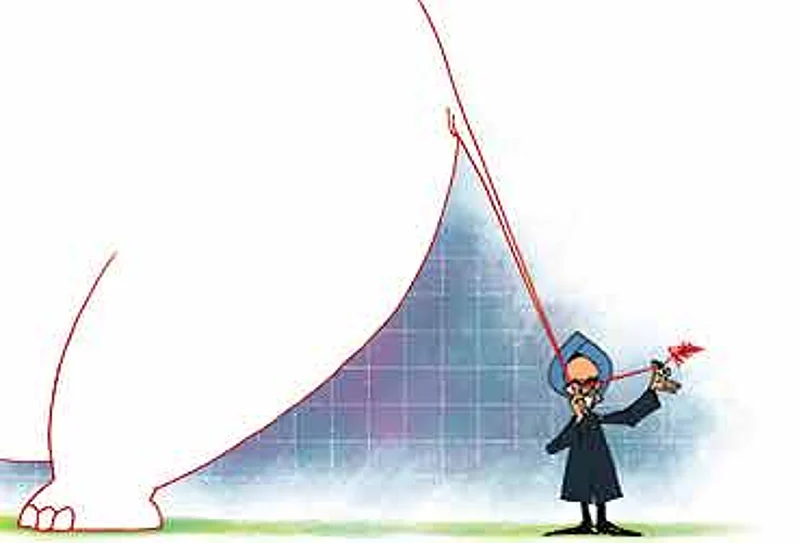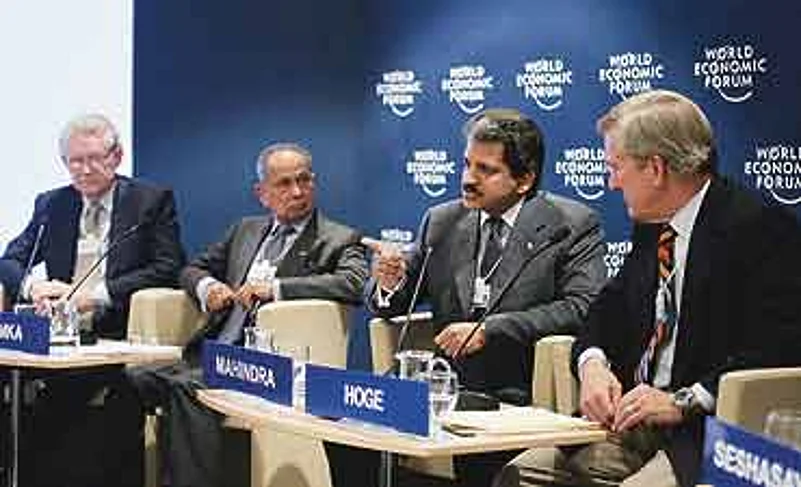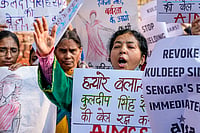The task has been made even more difficult by the 2006-07 budget. In terms of new decisions not taken or past decisions not changed, it has created a record of sorts in post-Independence India. And so it will be in terms of its passing—the finance bill was passed last week in the Lok Sabha with minimum discussion or debate, and just some minor riders.
Even if growth decelerates in 2006-07, there are a few broad and confident trends in the economy that give enough cause for cheer. The first is the definite upturn in revenue collection. Part of it is growth-induced, undoubtedly, but a lot of it is caused by sincere efforts by the tax administration, especially the Tax Information network (TIN). Perhaps, a few irritating taxes like the fringe benefit tax and the banking and currency transaction tax exist, but North Block babus, advisor Parthasarathi Shome in particular, are working hard to make, literally, every citizen of India pay his/her dues to the government. That is, everyone except the rich farmers. The way forward here is easy to read: a gradual removal of exemptions, vested interests permitting; a cleaner and simpler regime that’s easy to administer and easy to elicit compliance (that actually means no more cesses); and gradual widening of the service tax net.
The second is the salutary effect that growth has had this time on deficits. Of course, the effect may not be permanent, and the Fiscal Responsibility and Budget Management Act target still looks distant, but considering the impossible demands the present coalition has had on this government as well as the natural calamities, we could learn to be happy with a 4.1 per cent fiscal deficit and 2.6 per cent revenue deficit in 2005-06. Tackling the subsidy demon in the next year could mean winning half the battle here but its future continues to be clouded in this age of coalition governments.

The fiscal and revenue gaps have visibly reduced in the states too, but to sustain the balance at a healthy level, the states need to strengthen the VAT, tighten staff expenditure, and undertake reforms in their own subjects like agriculture, education etc on the ground. The third is the area of public investments where, after a long time (since the Fifth Plan actually), there is a healthy increase both in plan and non-plan investments in areas like agriculture, irrigation and rural roads. Most people forget that the maintenance of assets comes under non-plan revenue expenditure and an unreasonable demand to curtail that only erodes the value of the investments already made. All this will come under the flagship Bharat Nirman programme.
Which brings us to the last, and definitely not the least important, positives: delivery of public services. A very small step has been taken this year in this regard, yet it is one that could empower the Indian people like no law has before. The Right to Information Act passed last year will need at least a year of operation before one can evaluate its gains, but over time, its use can only increase.
However, there are concrete signs of a slowdown in growth. Both inflation and interest rates are likely to rise in 2006-07, though an abundant monsoon could alleviate some of the pressure there. Forex flows are slowing down and corporates could find it tough to better their previous exemplary performance. As finance minister P. Chidambaram said, "I’d be happy if I get 8 per cent again next year."
The budget’s professed insignificance this year has left the economy more or less on its own steam. Rightly so, because a lot of action now needs to happen in states. Especially in agriculture and in other ministries that are lagging way behind the finance ministry in reform initiatives. It is perhaps this, the Indian elephant’s slow pace, that has been factored into the decision to make 2010 the deadline for a countrywide goods and services tax. Finally, it may well take more than four years. Worse, considering the record of government tenures in the past 15 years or so, Chidambaram’s government is highly unlikely to be in power by then. As long as the government of the day does not backtrack on the promise, we’d be happy. But that could be a very big if, because the GST needs several legislative changes too.
Looking at the future, a few sectors will assume critical importance if India were to even work towards a 9-10 per cent growth. They are: agriculture, manufacturing, infrastructure and banking sectors. Both legal and administrative changes and some fast footwork at the state level are necessary for progress in all these sectors, barring banking. The government’s recent announcement of cheap and higher credit for farmers will severely affect bank profitability, at a time when interest rates are hardening and banks are increasingly told to put their own houses in order.

In the rest of these sectors, states have to take the lead and devise out-of-the-box ways to attract capital and cut red tape, be it for a steel manufacturing plant, or revitalising rural economy through food-processing, or innovate in distribution and management of power supply or create a special channel for land acquisition to build highways. Progressive states have been doing that for some time, it is time for the laggard states to shake themselves out of their tradition of buck-passing.
In agriculture, especially, states need to do much more than simply devise relief schemes for farmers. They have to work to modernise the agrarian economy through institution-building, and not only on seeds research alone. What is needed are institutions like free markets and a knowledge support system for farmers that enable them to plan cropping, harvesting and selling. Another normal monsoon year, which the year 2006 is likely to be according to current indications, may just send the state governments back to non-reform mode.
The most interesting change from a past tradition has been the sudden reduction in clamour for money at the Centre. And this could strengthen if—as the tax expenses statement has shown this year—the government decides to go ahead with removal of excise exemption (Rs 1,85,000 crore). As North Block officials never tire of explaining, this is desirable not only to get more money in the hands of the government for essential public investments, but also to clean up the inherent biases in the system by pitting one industry against another (since most of the protection is now outdated) but also to straighten out the high-cost disadvantage of Indian manufacturing. More interesting, a complementary part of this exercise will allow easy entry and exit of industries. Excise reform thus will be one of the things to watch out for in the coming years.


























